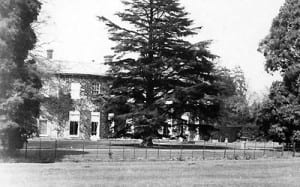 Warfield Park, Berkshire
Warfield Park, Berkshire
Longing, Belonging and the Country House
by Kate Smith
Please note that this case study was first published on blogs.ucl.ac.uk/eicah in April 2013. It was last checked by the project team on 19 August 2014. For citation advice, visit ‘Using the website’.
How did the processes of empire shape how individuals perceived and conceived of the country house in eighteenth- and early nineteenth-century Britain? Peter Mandler has argued that in the early nineteenth century the country house began to be recognized as part of Britain’s national heritage. [1] Despite focusing on this later period, Mandler also identified certain changes in the later eighteenth century which precipitated such ‘heritage consciousness’.[2] These included the ‘Picturesque’ movement and its affirmation of particular landscapes as ‘English’ and a renewed interest in English traditions in art and architecture with particular reference to the Gothic. Building on Mandler’s work, this case study questions how imperial agents’ increasing connection to country houses impacted upon the idea of the country house. More particularly it asks, did the longings, which East India Company officials and their families bore for ‘home’, England and their country houses, mark the country house as an important component of a specifically ‘English’ landscape and thus precipitate its entry into the heritage consciousness?
This case study begins to answer these questions by exploring the biographies of different individuals within the Walsh family. Over at least three generations, the Walsh family were significantly involved with the East India Company (EIC). Consequently, different members spent considerable periods of their lives in India, an experience which led them to continually reassess their relationship to and understanding of ‘home’ and ‘England’. Earlier generations of the family imagined not necessarily a ‘home’ in England, but rather a space ‘England’ and used it to ground their Indian experiences. In contrast later generations focused upon a particular place, Warfield, which conjured up ideas of belonging. Once returned to England, they invested this domestic space with time, effort and money. As generations of the Walsh family moved into and out of Warfield they altered and improved it in different ways, creating it anew. By examining the Walsh’s relationship to Warfield, this case study also uncovers how the country house played an important role in EIC officials and their families’ conceptions of place and home.
Warfield Park was demolished in 1955, a year in which one historic house was being demolished every five days. Increased death duties, post war social change, new planning legislation and falling land rents all impacted upon country houses, making them increasingly vulnerable.[3] Notably then, this case study examines a house whose material presence has been lost. Nevertheless, aspects of the house and the meanings it held can be examined through the correspondence and diaries of the individuals who lived there or experienced a connection with it. An important source within this case study is a memoir, written by the son of one of Warfield’s key inhabitants Margaret Benn Walsh. In writing the memoir, John Benn Walsh (1798-1881) who was to become first Baron Ormathwaite, attempted to write a full and entirely positive account of his mother and the life she led using letters and diaries from his family’s collection. Although problematic, this source highlights the important role that houses played in the lives of his great uncle, his mother and father and himself. In both material and immaterial terms houses defined many members of the Walsh family. Although the physical structure of Warfield no longer exists, its imagined presence remains recorded in this set of correspondence, diaries and the memoir. Its material presence was often, and in this case study is yet again, secondary to the imaginings it inspired.
Imagining Home
In the eighteenth century, the Walsh family sustained multiple ways to the East India Company (EIC) and its activities. Three generations of the family lived in India for sustained periods of time. For the second generation, returning to India (they were born there and then returned as adults) encouraged them to consider their relationship to England and ‘home’. This section of the case study examines what form those considerations took to reveal the importance these individuals began to place on ideas of England.
A Country House of One’s Own
When returning to England, how did East India Company officials and their families marry the England they imagined to that that greeted then? For the Walsh family, on their return home they created another important place in both imagined and material terms. Warfield Park grew to be a significant family reference point, whether at home or abroad.
Rebuilding Warfield
When John Walsh died in 1795 Warfield passed to his nephew-in-law, Margaret’s husband, John Benn Walsh. Warfield then enjoyed the benefits of Margaret and John’s efforts to improve and manage the estate. They invested both time and money in the house over a sustained period.
A New Generation
In 1819, when John and Margaret Benn-Walsh’s son John came of age, John Walsh’s will ensured that he inherited all the family properties. Nevertheless, it seem s that the family continued to live together at Warfield until 1825. In that year Margaret’s husband John Benn-Walsh died after suffering a series of strokes and six months later John married. Margaret, now a dowager, began to look for a new country house.
To read the case study in PDF format, click here.
Acknowledgements
The text and research for this case study was primarily authored by Dr Kate Smith.
[1] Peter Mandler, The Fall and Rise of the Stately Home (New Haven and London: Yale University Press, 1997), p. 7.
[2] Mandler, The Fall and Rise, p. 21.
[3] Roy Strong (ed.), The Destruction of the Country House, 1875-1975 (London: Thames and Hudson, 1974).



